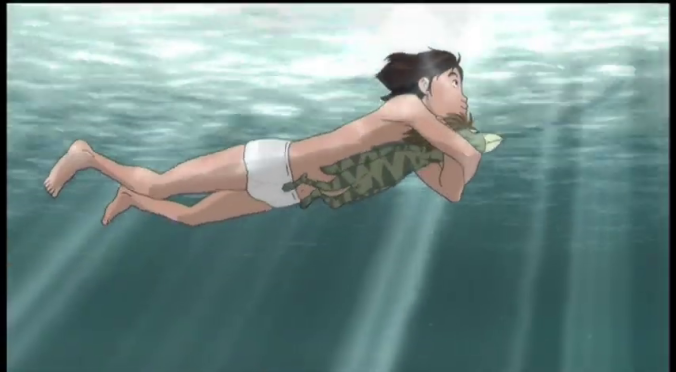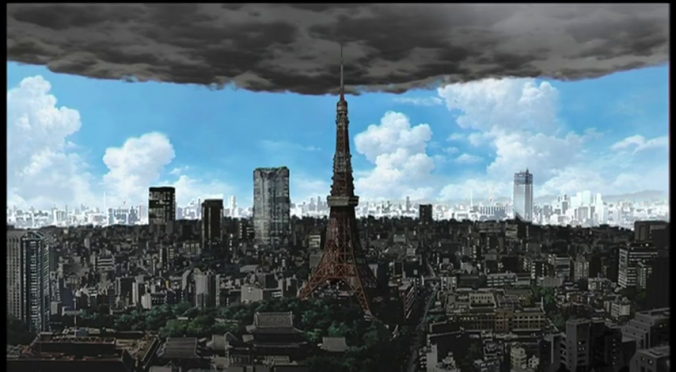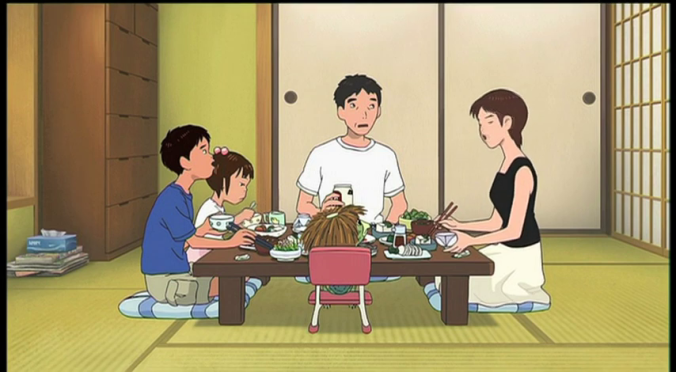 Coo is a kappa, a legendary water creature of Japanese folklore. By accident, young Koichi in modern Tokyo finds what looks like an interesting fossil, but as he cleans it in water, the kappa gradually returns to life. The kappa is immensely grateful and, in the way of animated features everywhere, becomes friends with Koichi. Eventually the pair makes three significant trips.
Coo is a kappa, a legendary water creature of Japanese folklore. By accident, young Koichi in modern Tokyo finds what looks like an interesting fossil, but as he cleans it in water, the kappa gradually returns to life. The kappa is immensely grateful and, in the way of animated features everywhere, becomes friends with Koichi. Eventually the pair makes three significant trips.
The kappa’s first sound is “ku,” from which he gets his name. He is actually still a boy and soon adopted as another child of the family. Kappas resemble turtles but have a shock of hair and a little plate on top that looks like a monk’s tonsure; if that bowl dries out, they are weakened and can die. They also love sumo, and though he is little, he defeats even the father, eventually teaching Koichi sumo moves that will allow him to defeat the class bully. At night, the two go to the local stream that was once Coo’s home, and they swim and play, Coo demonstrating his fart-propelled swim. But there is no swamp left and the river is no longer wild, so there are no more kappas.
Koichi then decides to take Coo to Tono, a place famous for its kappas. Tono is in the north, historically a marshy area that has now been completely drained and turned into a tourist town, full of kappa statues and mascots and souvenirs, but no real kappas. Koichi is still in grade school, about twelve at most, and he goes alone with Coo in his backpack. He does not run away but has his parents’ permission – mother only insists that he call on the cell phone every day – and the inn-keepers rent him a room on his own. Similar independence of Japanese schoolchildren of about the same age has been seen before, but it is still almost shocking even in a cartoon to the eyes of modern America, where a child showing up alone at a hotel hundreds of miles from his home would bring out the police almost immediately. Koichi manages to negotiate several different trains without help or danger, including the bullet train, while Coo watches from a slightly opened backpack. Unable to find any other kappa, Koichi takes Coo for a swim in the ocean, where the salt water stings his bowl and the fish taste too salty.
There is even a massive reward in Tono for anyone catching a real kappa, and for a while we think we are headed toward a movie about Coo’s attempt to evade people who want to put him in a cage. But Coo’s escape is of a different kind. Back home, through Koichi’s little blabbermouth sister, word leaks out about the kappa, which eventually leads not to nasty men who want a reward but to a media frenzy outside the home. This leads Coo on his second and most dangerous trip. In an effort to lift the media siege, the salaryman father agrees to bring the family to a TV show that his company sponsors. After the producers find some boy’s shorts to hide Coo’s penis, everything goes well and Coo is the darling of the audience. Then a famous ethnologist appears to talk about the kappa history, and he is the spitting image of the samurai who had killed Coo’s father in the 1600s. Not only that, he has a mummified arm of a kappa that has been handed down through his family and which Coo immediately recognizes as the arm the samurai had sliced off when his father very politely, as meekly as a peasant trying to talk to a samurai, had requested that the samurai not drain the marsh.
In a panic, he seizes the arm, mysteriously shatters the lenses of the cameras, and tries to run. Ossan the family dog has broken free and tries to come to his rescue, but Coo is eventually pursued by the journalists and crowds to the Tokyo Tower, symbol of all of Tokyo’s modernity.  There he climbs high up, carrying his father’s arm all the way, and finding no hope of a home in the urban landscape, prepares to jump. But a great dragon appears, bringing a rainstorm that replenishes his bowl, and he is rescued.
There he climbs high up, carrying his father’s arm all the way, and finding no hope of a home in the urban landscape, prepares to jump. But a great dragon appears, bringing a rainstorm that replenishes his bowl, and he is rescued.
Still basically imprisoned in the house by the media, Coo receives a mysterious letter that invites him to ship himself to a strange address. Koichi packs him up with the arm, some fish, and a bottle of water, and the package arrives in faraway Okinawa at the home of a demon who knows how to take human form and saw Coo on TV.
Among the flood of Japanese anime movies released in the early 21st century, Summer Days with Coo was one of the most highly regarded in Japan but it somehow escaped much notice outside its borders. Unlike the Studio Ghibli movies, for example, it has no English dubbed version that I could find. Perhaps this was because the kappa itself required too much explanation, perhaps it was because he had a very visible penis, perhaps it was because it was less of a commercial than a critical success in Japan, or perhaps it was just one of the vagaries of movie distribution. Nevertheless it is one of the richest of Japanese anime in its themes. Not only do we have the strange visitor in a family, whose arrival and family life and eventual departure is not unlike ET, but we also have the depiction of the difficult school years of pre-adolescence. Most significant however is the concern that modern Japan was losing its culture in its wave of “modernization.” The natural world itself has become little more than a theme park, and there is increasingly little home for the things that made Japanese life unique and meaningful.
Koichi’s family still lives partially in the traditional world. Koichi has his own room with a bed, but mother and father sleep on futons with the daughter between them. The family dines at the chabudai, but with a short baby chair for the daughter taken over by Coo, much to her resentment.  Though no one has ever seen a kappa, everyone immediately accepts that Coo is the real thing, even the media, and there is no effort to prove a scam.
Though no one has ever seen a kappa, everyone immediately accepts that Coo is the real thing, even the media, and there is no effort to prove a scam.
The backgrounds are meticulously detailed and often lovely, while the humans, though simplified, are drawn without any obvious caricature. This is quite a change for director Keiichi Hara, who had become famous through his work on the much more stylized and wild Crayon Shin-chan franchise movies. The movie is unusually long for animated features, a bit longer even than Princess Mononoke, so it seems too long for a children’s movie, but it never seems to drag. It is a lovely family movie, not just a movie for children that the parents can tolerate, while offering insights into the continuing Japanese concerns about the potential loss of Japanese culture.
Lovely discovery. Caution for watching with children: the wise old family dog has a backstory of an abusive owner and …. the dog dies.
LikeLike
We might also add that even before the credits we see Coo’s father cut down and sliced apart by the samurai; in the long run, it is no worse than the death of Bambi’s mother, but for pre-schoolers, it is a traumatic way to begin a movie.
LikeLike